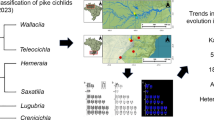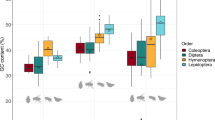Abstract
The genomic structure of two morphological forms of the pyurid ascidian Herdmania momus — H. momus forma curvata and H. momus forma grandis—are compared using a rapidly evolving highly repetitive element isolated from the genome of H. momus forma curvata. A 663 bp (base pair) Cla I satellite sequence is present only in the genome of H. momus forma curvata, and hence can be used as a form-specific marker. Low-stringency Southern blot analyses, using the Cla I satellite as a probe, revealed that the genomes of H. momus forma grandis and another pyurid ascidian, Pyura stolonifera, do not contain similar sequences to the H. momus forma curvata repetitive element. In addition to this genomic dissimilarity, there are a number of significant reproductive and developmental differences between the two H. momus forms, and interform fertilisation rates are significantly lower than intraform rates. The molecular, reproductive and developmental differences between H. momus forma curvata and H. momus forma grandis indicate the presence of strong barriers to gene flow.
Similar content being viewed by others
References
Arnason U, Best PB (1991) Phylogenetic relationships within the Mysticeti (whalebone whales) based upon studies of highly repetitive DNA in all extant species. Hereditas 114: 263–269
Bates WR, Jeffery WR (1987) Alkaline phosphatase expression in ascidian egg fragments and andromerogens. Devl Biol 119: 382–389
Degnan BM (1991) The ascidian Herdmania momus as an experimental model for molecular studies in development and evolution. Ph.D. thesis. University of Queensland, Brisbane
Degnan BM, Lavin MF (1991) Identification of cis-regulatory sequences in ascidian ribosomal DNA using a rapid filter-binding assay. Gene 109: 249–253
Degnan BM, Yan J, Hawkins CJ, Lavin MF (1990) rRNA genes from the lower chordate Herdmania momus: structural similarity with higher eukaryotes. Nucleic Acids Res 18: 7063–7070
Dover GA (1982) Molecular drive: a cohesive mode of species evolution. Nature, Lond 299: 111–117
Dover GA (1986) Molecular drive in multigene families: how biological novelties arise, spread and are assimilated. Trends Genetics 2: 159–165
Dover G, Brown S, Coen E, Dallas J, Strachan T, Trick M (1982) The dynamics of genome evolution and species differentiation. In: Dover G, Flavell R (eds) Genome evolution. Academic Press, New York, p. 343
Feinberg AP, Vogelstein B (1984) A technique for radiolabeling DNA restriction endonuclease fragments to high specific activity. Analyt Biochem 132: 6–13
Inoue H, Nojima H, Okayama H (1990) High efficiency transformation of Escherichia coli with plasmids. Gene 96: 23–28
Jeffery WR (1985) Specification of cell fate by cytoplasmic determinants in ascidian embryos. Cell 41: 11–12
John B, Miklos G (1988) The eukaryotic genome in development and evolution. Allen & Unwin, London
Kawamura K, Fujita H, Kakauchi M (1989) Concanavalin A modifies allo-specific sperm-egg interactions in the ascidian, Ciona intestinalis. Dev Growth Differentiation 31: 493–501
Knowlton N (1993) Sibling species in the sea. A Rev Ecol Syst 189–216
Kott P (1952) The ascidians of Australia. I. Stolidobranchiata Lahille and Phlebobranchiata Lahille. Aust J mar Freshwat Res 3: 205–334
Kott P (1964) Stolidobranch and phelobobranch ascidians of the Queensland coast. Pap Dep Zool Univ Qd 2: 127–152
Kott P (1972) The ascidians of South Australia. I. Spencer Gulf St. Vincent Gulf and Encounter Bay. Trans R Soc S Aust 96: 1–52
Kott P (1985) The Australian Ascidiacea. Part I, Phlebobranchia and Stolidobranchia. Mem Qd Mus 23: 1–440
Kumar S, Degnan BM, Lavin MF (1988) Cloning of a major repeat DNA sequence from Pyura stolonifera. DNA 7: 433–439
Lee Y-H, Vacquier VD (1992) The divergence of species-specific abalone lysins is promoted by positive Darwinian selection. Biol Bull mar biol Lab, Woods Hole 182: 97–104
Michaelsen W (1919) Die krikobrachen Ascidien des westlichen Indische Ozeans: Claveliniden und Synoiciden. Jb hamb wiss Anst 37: 1–74
Palumbi SR (1992) Marine speciation on a small planet. Trends Ecol Evolut 7: 114–118
Palumbi SR, Metz EC (1991) Strong reproductive isolation between closely related tropical sea urchins (genus Echinometra). Molec Biol Evolut 8: 227–239
Reverberi G (1971) Ascidians. In: G Reverberi (ed) Experimental embryology of marine and freshwater invertebrates. North-Holland Publishing Co, Amsterdam
Rosanti F, DeSantis R (1978) Studies on fertilization in the ascidians. I. Self-sterility and specific recognition between gametes of Ciona intestinalis. Expl Cell Res 112: 111–119
Sambrook J, Fritsch EF, Maniatis T (1989) Molecular cloning. A laboratory manual. 2nd edn. Cold Spring Harbor Laboratory, New York
Sardet C, Speksnijder J, Inoue S, Jaffe L (1989) Fertilisation and ooplasmic movements in the ascidian egg. Development (UK) 105: 237–249
Stobart B, Benzie JAH (1994) Allozyme electrophoresis demonstrates that the scleractinian coral Montipora digitata is two species. Mar Biol 118: 183–190
Turner BJ, Elder JF, Laughlin TF (1991) Repetitive DNA sequences and the divergence of fish populations: some hopeful beginnings. J Fish Biol 39: 131–142
Vacquier VD, Lee Y-H (1993) Abalone sperm lysin: unusual mode of evolution of a gamete recognition protein. Zygote 1: 181–196
Author information
Authors and Affiliations
Additional information
Communicated by G.F. Humphrey, Sydney
Rights and permissions
About this article
Cite this article
Degnan, B.M., Lavin, M.F. Highly repetitive DNA sequences provide evidence for a lack of gene flow between two morphological forms of Herdmania momus (Ascidiacea: Stolidobranchia). Marine Biology 124, 293–299 (1995). https://doi.org/10.1007/BF00347133
Received:
Accepted:
Issue Date:
DOI: https://doi.org/10.1007/BF00347133




